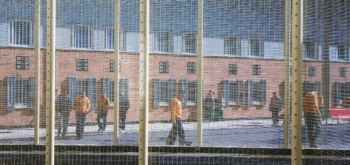Criminalising everyday care

Photograph: Andrew Aitchison/ Prison Image (Wandsworth prison)
Mark Smith, a senior lecturer in social work at the University of Edinburgh, on the demonsiation of care workers
The current inquiries into historical child abuse in England and Wales and in Scotland entail that, once again, the actions of residential care workers come under heightened scrutiny.
As a former residential child care worker turned social work academic, I have come uncomfortably close to cases of historical abuse over the past dozen or so years. I have given statements to both prosecution and defence and have been a witness in court cases where I have worked directly with the accused and in an expert capacity.
Without being diverted too much from the focus of this piece, it is fair to say that I have not come across a case yet where I have been convinced of guilt. In fact, I have been horrified by the flimsiness, indeed the banality, of the evidence that finds its way to court.
Not only that, I found myself thinking on hearing of some charges; ‘I’ve done that.’ One of the conclusions I draw is that the prosecution of historical cases owes very little to evidence of actual abuse but is driven by shifting attitudes and assumptions about how to care for children. This reflects the colonisation of child care by a far narrower notion of child protection and the insinuation of what have become dominant child protection orthodoxies into legal systems that seem unable to recognise that the this emperor wears very few clothes.
The particular experience that prompts these reflections involves an interview with a police officer about a case in which a former colleague was accused (and subsequently convicted, in my view wrongfully) of abusing boys in a residential school we both worked in.
One of the questions I was asked was if, when supervising boys, it would be normal for staff to enter the shower room. The reality was that over the course of the 1980s, there might have been 15-20 boys to shower of an evening. In previous decades there would have been considerably more. To do so and to ensure that they were indeed showering and weren’t messing about, staff did have to enter the shower room if they were to do their job properly. But more than that, the kind of taboos and suspicions that surround nudity in the present day just didn’t exist.
In fact, much of the practice culture and the literature at the time encouraged adults to be relaxed about nudity, so as children could become comfortable with their own bodies. So, I replied that I did enter the shower room on occasion and sought to explain the context set out above.
I went on to add, that after sports or swimming, staff would shower alongside boys. Rather than accept this as a description of everyday practice, the policewoman advised that she would not record this section of the interview, as the prosecution might use it against me were I to be called as a witness.
In this, I have no doubt that she thought she was acting in my best interests and she may have been. The underlying sense, though, was that she believed such practices to have been suspect and was aware that others would, too. The upshot of this is that the police, informed by generally self-proclaimed child protection experts, have become the arbiters of how we look after children.
What has become this dominant notion of privacy lacks wider context. The kind of practices outlined above weren’t peculiar to residential schools. They were common wherever adults and kids came together in sporting activities. In the school I worked in in the 1980s, a couple of local policemen would bring their sons and would join staff members and residents in a game of five-a-side football every Friday evening. And we would shower together afterwards. And, in situations where showering was but one aspect of everyday shared living, cold water may have been thrown about – bodies flicked with rolled-up towels.
All of this was done in fun – I don’t believe for a minute that any boy was traumatised, a massively over-used word, by such experiences. Yet, former care workers are now being prosecuted and convicted for such everyday and in my experience, innocent, practices and which no-one at the time would have remotely considered to come under the ambit of criminal law.
Yet, any former resident might now look back on their care experience and identify practices that present day sensibilities would deem to be abusive, even if they were never intended or experienced as such at the time.
A number of implications flow from this state of affairs. It is not just the odd ‘bad apple’ that risks becoming caught in the cross hairs of the various inquiries – every one of us who worked in residential care settings might find ourselves there. The practice of care is intimate and messy – care workers, day and daily do things that an over-zealous police officer or social worker might label as criminal. And the process through which individuals become the object of the witch’s finger is not the result of detailed and honest investigation but of whether or not and how often one’s name is mentioned in dispatches – it is utterly capricious.
A worrying scenario is that, in a situation where the current child abuse inquiries are not unearthing the numbers of abuse claims from residential care settings that they anticipated, the possibility of reframing everyday practices as abusive might lend a much needed legitimacy to troubled institutions.
An irony in all of this is that much of the discourse around state responses to historical abuse is framed around human rights abuses. In criminalising quotidian acts of care, state organised institutions and processes open their deliberations to claims of retrospective justice, in contravention of the European Convention on Human Rights.
As Richard Webster observed is his book The Secret of Bryn Estyn: the making of a modern witchhunt (Oxford: The Orwell Press, 2005) we compound a historical ingratitude to care workers by demonising them.
This article was published July 13, 2107






